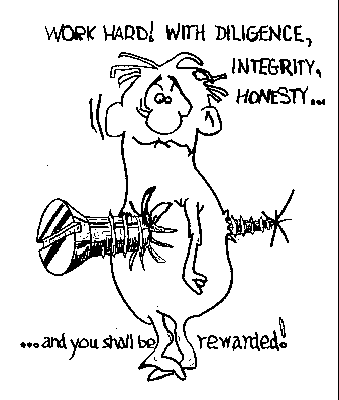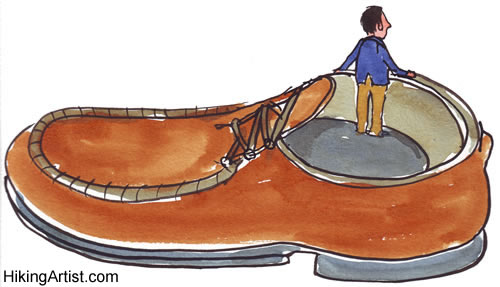|
|
|
Monday, March 23rd, 2020

Poking through 14+ years of posts I find information that’s as useful now as when it was written.
Golden Oldies is a collection of the most relevant and timeless posts during that time.
I was reminded of this article after reading one by Wally Bock that I will share tomorrow. I’ve always found it interesting that certain words, such as influence, are assumed positive, while manipulation is negative.
Read other Golden Oldies here.
There is a dangerous assumption out there that ‘leaders’ are chuck full of positive traits and on the side of the angels, but I’m here to tell you that it ain’t necessarily so. Just as leaders come in all shapes, colors and sizes they come with a wide variety of traits, not all of them positive. But it seems as if succession is tough all over.
Italian police have caught the Sicilian Mafia’s number two, the latest in a string of top-level arrests that has given the crime group that once terrified Italy problems with rebuilding its leadership.
The hero CEO who will save the company easily morphs into the imperial CEO. An intelligent, thoughtful opinion piece by Ho Kwon Ping in Singapore considers the dangers of this happening and assumes it will continue in the US—and it probably will.
The leadership of any company is critical to the success of its mission — but no one individual is mission-critical.
Yesterday I wrote Real Leaders are Fair, which means applying rules equally, but that rarely happens, especially when a government is involved and ours is no different. Consider the non-application of a federal law backed by a presidential proclamation that prohibits corrupt foreign officials and their families from receiving American visas. But business interests always seem to trump fairness.
“Of course it’s because of oil,” said John Bennett, the United States ambassador to Equatorial Guinea from 1991 to 1994, adding that Washington has turned a blind eye to the Obiangs’ corruption and repression because of its dependence on the country for natural resources. He noted that officials of Zimbabwe are barred from the United States.
Finally, on a lighter note, I found the answer given by Ask the Coach to this question to be classic.
Q: I am having a difficult time leading my team. The team members will not follow my instructions, which I am sure would make our project much more successful. What am I doing wrong?
A: What you’re doing wrong is very simple: you have simply forgotten that your team is more critical to the success of your project than you are.
Take a moment and read the whole post, I guarantee you’ll like what you learn.
And if you want more of my picks you’ll find them here.
Posted in Golden Oldies, Leadership | No Comments »
Tuesday, December 3rd, 2019

A long time ago I wrote about what I call ego-merge, which refers to buying into the idea that you and your company are one.
Ego-merge used to be the result of long-term employment with the same company; these days it’s more the result of buying too deeply into the founder’s vision.
“The initial thing of ‘making a life, not a living,’ ‘community,’ ‘better together’ — the terms WeWork pushed as marketing also seeped into this company’s culture in a very real way,” said Kevin Hsieh, a software engineer involved in the group. “There is a looming sense of betrayal and frustration that that wasn’t necessarily followed everywhere.”
Betrayal is no understatement.
Adam Neumann, WeWork’s CEO, walked away with a $1.7 billion golden parachute, while employees are getting worse than screwed.
Combining an intriguing vision, with intense passion and an invincible belief in self, is a recipe that can hook investors, workers and users — and it did.
Caveat emptor, indeed.
Posted in Communication, Culture, Personal Growth | No Comments »
Tuesday, August 21st, 2018

With 68% of employees disengaged, you would think the board’s critical eye would be turned on the executive suite.
You would think wrong.
One of the greatest causes of disengagement is the difference in compensation between the CEO/executives and the workers.
That difference is the direct result pay-for-performance, coupled with the board’s ego-driven competitiveness and desire for bragging rights.
Name the most brilliant, talented, past or present CEO you can think of, then remove them from their position.
The company may hiccup, but it won’t go down in flames.
Now remove all the line managers/team leaders OR all the workers in a specific department or with a specific talent and watch the company stagger and fall on its face.
An unintended consequence of pay-for-performance is we treat companies as if they are in the airline business, except the only person who matters is the pilot—not the grounds crew, nor the quality control tinkerers, nor the guys who wrangled the ore and fuel from the ground, forged the parts, tightened the bolts and soldered the frame.
In their rush to acquire the “best” talent, boards are likely to forget that corporations are not independent entities
It’s a group of people all moving in the same direction, united in a shared vision and their efforts to reach a common goal.
To move in the same direction people need to be engaged.
But how engaged would you be when the proceeds of your hard work show up in someone else’s paycheck?
In the 1970s, shareholders took out about 50% of a company’s profits, while the rest was reinvested in the productive capacity of the firm, including R&D to employee training and rewards. Today, the shareholder gets over 90% between dividends and share buybacks. Today, a 60% or greater weight on equity or equivalents is the norm in pay packages.
Dominantly CEO/ senior pay packages.
The funny thing is that rank and file aren’t looking for similar pay.
They are looking for fairness in relative pay.
Image credit: JustyCinMD
Posted in Compensation, Culture, Ducks In A Row | No Comments »
Friday, April 6th, 2018

A Friday series exploring Startups and the people who make them go. Read all If the Shoe Fits posts here.
I often field questions about compensation, stock allocation and bonuses that revolve around the idea of fairness.
There have been more calls since a rise in media attention to gender pay inequities, especially focused on tech. They look at what other countries are doing, such as a recent UK law, and wonder if similar things could happen here or if someday down the line they will have to do as Marc Benioff did.
Whether the subject starts with diversity or compensation, my callers fall in two distinct camps.
- Those looking for ways to bake fairness into their company’s DNA; and
- The ones who want to cloak current unfair actions in a veneer of acceptability.
(I have to admit that listening to the second group stumble around trying camouflage what they want to do is amusing, but definitely not funny.)
Of course, it’s easiest for founders just starting, since they have no historical staff or (hopefully) bad habits, but any size organization can do it if management is determined and has the grit to follow-through.
Here are some basics actions:
- Develop core values around fairness, diversity, transparency, etc., make both values and culture public on their site, and follow-through when recruiting.
- Salary and stock offers should be based on the value and effect of the position on the company’s success, as opposed to the person you are hiring.
- Before approving compensation compare it with similar people inside and out for fairness, especially if the candidate is a woman or minority.
- Talk to others, such as Gusto cofounder and CTO Edward Kim or the folks behind the Founders for Change coalition.
The most critical factor is a willingness to pass on hiring people when it’s obvious they are assuming it’s just talk or that you should make an exception for them because they are special.
As I’ve said in the past, “If you pay your people equally when you hire and promote there won’t be a pay gap for you to erase.”
Image credit: HikingArtist
Posted in Compensation, Culture, Hiring, If the Shoe Fits | No Comments »
Monday, July 24th, 2017
It’s amazing to me, but looking back over more than a decade of writing I find posts that still impress, with information that is as useful now as when it was written.
Golden Oldies are a collection of what I consider some of the best posts during that time.
Companies constantly talk about what they are doing to incentivize productivity and innovation. Incentives are supposed to help drive performance. Recognition is very important as are financial rewards — as long as they are seen as fair. If not, they act more as disincentives, as seen in the first post.
The second focuses on sales incentives.Maximizing revenue generation, AKA, sales, is a top priority for every business, from micro startups through the Fortune 10. Commissions have always played a significant role incentivizing salespeople — until they don’t.
Read other Golden Oldies here.
The Reward Should Fit the Act
 Are you familiar with the saying “let the punishment fit the crime?” Are you familiar with the saying “let the punishment fit the crime?”
It’s a valid approach, but it’s just as true that the reward should fit the action.
A friend of mine works for a Fortune 1000 company in a tech support role. He’s well respected lead tech in his group.
Last year he developed an idea on his own time and gave it to his company.
As a result, he was flown to annual dinner and presented with an award and a $5000 bonus.
Sound impressive?
His idea will save his company $5 million or more each year.
Still impressed?
My friend isn’t.
He has a friend who is very impressed, but that’s because his company doe nothing; no recognition whatsoever.
My friend feels that a $5K reward for saving the company $5M or more every year, while being better than nothing, is still just short of an insult.
Other than being disappointed what’s the fallout?
He likes his job and his boss, so he’s not planning on leaving, but…
He has another idea that he’s not going to bother developing.
He’s still one of the most productive people they have, but that extra edge is gone.
What do you think his employer should have done?
Join me tomorrow for another look at how, to quote another old saying, companies keep cutting off their noses to spite their faces.
Image credit: dinny
Ducks in a Row: Incentive Stupidity Knows No Bounds
 Yesterday I told you how a company squashed my friend’s initiative by giving him a bonus that had no relationship to the value he provided them in annual savings. Yesterday I told you how a company squashed my friend’s initiative by giving him a bonus that had no relationship to the value he provided them in annual savings.
This reminded me of something that happened back in the early 1980s when sales was truly dependent on the skill, relationships and reputations of salespeople.
Another guy friend, another incredibly stupid company.
In a nutshell,
- Guy outsold every salesperson both internally and at the competition. He had years of experience; relationships with customers that didn’t quit and unmatched skill at understanding customers and convincing them that his company (whichever it was) had the best solution available.
- One day guy was called into the CFOs office and told that his commission was being capped.
- He was on track to earn more than the president and that was unacceptable; he asked if they were sure that was the only solution and told yes.
- Guy proceeded to write a resignation letter on a sheet of paper he borrowed from the CFO.
- He left the offices without speaking to anyone.
- By the time he reached home there were three name-your-own-terms offers from competitors on his voicemail.
- He started with his new company the next day.
Over the years I’ve found that actions like these usually come from the company’s bean counters. (In this instance, ‘bean counters’ is definitely a derogatory term.)
Apparently, some bean counters involved never learned to do the math.
In both cases the actual cost was zero, since they were funded from direct actions well beyond anything expected of the employees involved.
The lesson here is that you never cap a commission and the reward for saving $5 million annually should be at least 1% of one year ($50,000) as opposed to .001% ($5,000).
I realize it’s difficult for some financial types, executives and managers to understand, but that is why bonuses and commissions are called incentives—not disincentives.
Image credit: Finsec
Posted in Compensation, Golden Oldies, Motivation, Retention | No Comments »
Monday, April 17th, 2017
It’s amazing to me, but looking back over more than a decade of writing I find posts that still impress, with information that is as useful now as when it was written.
Golden Oldies are a collection of what I consider some of the best posts during that time.
Money. Everyone’s favorite subject that no one wants to talk about. Especially when it comes to work, as in, “what were you making previously” and “what are you looking for now?”
Tomorrow’s post focuses on a new law enacted in Philadelphia and New York City that has the potential to change that entire, unwanted conversation, forcing managers/companies to focus on the future, as opposed to history.
Read other Golden Oldies here.
 In a post last week I asked for opinions on the ideas presented in a series of articles in Business Week on managing smarter but especially one that claims that “treating top performers the same as weaker ones is ‘strategic suicide’” and said I would add my thoughts in a future post. In a post last week I asked for opinions on the ideas presented in a series of articles in Business Week on managing smarter but especially one that claims that “treating top performers the same as weaker ones is ‘strategic suicide’” and said I would add my thoughts in a future post.
Bob Foster left two interesting comments (well worth your time to click over and read). Regarding pay for performance he tells the story of a company where everybody from the CEO down all quit.
“Taking on the task to salvage the company, I hired new people that met unusual qualifications: they had to be qualified for the job they were applying for; they had to be unemployed and available immediately; they had to work at sub-standard wages; they had to work while knowing the company could close at any minute; and they had to work without supervision. The team that came together produced a highly successful company, and it was not because of high pay, or performance bonuses (there were none). The team stayed together, and performed, because of mutual respect, trust, appreciation, and consideration—people were ‘valued.’ To me, this is the truest form of ‘pay for performance.’”
I agree that trust was one of the key ingredients in what Bob accomplished, but it wasn’t the only one—or maybe I should say that it needs to be based on fairness and honesty.
Bob says the pay was ‘sub-standard’, but I assume that it was universally sub-standard relative to position and experience. If he had chosen to pay part of the team, say 10% more than their peers, the team wouldn’t have coalesced.
And that is exactly why I disagree with the idea of paying top performers, AKA stars, big sign-on bonuses or higher salaries than their peers.
- Based on my own experience, 98% of star performers become stars as a function of their management and the ecosystem in which they perform. Change the management, culture or any other parts that comprise that ecosystem and the star may not survive.
- Just as a chain is as strong as its weakest link there is no star in any sport, business, media, etc., who can win with a team that is subject to constant turnover and low morale.
Consider this common example.
Two people are hired at the same time with the same background, same GP0 and similar work experience, but with the one exception. One graduated from a ‘name’ school and the other from a community college. Starting salary is $50K, but the manager adds a 20% premium to the first candidate’s offer on the basis that she must be better to have gone to that school.
Neither candidate lived up to their potential because the manager made poor choices. In doing so he set both up to fail but for different reasons; one thought she had it made and the other that he was low value.
Merit bonuses fairly given for effort above and beyond acceptable performance levels make sense as long as they don’t come at the cost of developing new talent.
But one problem with ‘pay for performance’ is the pay often comes before the performance, but there are others and I’ll discuss them more Thursday. In the meantime, here are links to five posts from 2006 that give more detail on the trouble with stars.
Stars—they’re in your MAP
More about stars and MAP
Rejects or stars?
Star compensation
Retaining Stars
Image credit: sxc.hu
There were several interesting comments on the original post; check them out.
Posted in Compensation, Culture, Golden Oldies, Hiring, Motivation, Retention | No Comments »
Tuesday, March 29th, 2016

An interesting article in the Washington Post focuses on a study that shows people are less stressed if their boss is consistently unfair than if she is unfair one minute and fair the next.
“Intuitively, you would think the more fairness you get, the better,” said Fadel Matta, a researcher at Michigan State University and the lead author of the paper, in an interview. “But that’s not what we demonstrated. It’s better if supervisors are a consistent jerk than if they’re fair sometimes and not fair other times. People want to know what they can expect when they come into work.”
Reading that reminded me of something I wrote back in 2009.
The action is inconsistency and the primary effect is fear. Secondary effects include intimidation and insecurity. (…) It’s not knowing that really gets to people—even more than expected abuse. (…) That fear grows exponentially once it takes root and distrust typically increases at the same rate.
As far back in history as you care to go, no matter the circumstances — work, personal, relationship, religious — inconsistency has always been a negative.
What also seems to be a constant, in this case in the workplace, is the inability for bosses’ opinions of themselves to accurately reflect their employees’ take on the same subject — although the disconnect does embody a kind of consistency.
In short, when evaluating your own actions for consistency don’t ask yourself, your boss, or your peer.
Ask the people who actually experience you every day of their lives.
Ask your team.
Flickr image credit: Susanne Nilsson
Posted in Culture, Ducks In A Row, Personal Growth | No Comments »
Wednesday, September 16th, 2015
 The other day I was thinking about downloading an ad blocker, because the auto-video ads make me crazy. The other day I was thinking about downloading an ad blocker, because the auto-video ads make me crazy.
But even before I read about the Washington Post blocking people with ad blockers from reading their articles I decided not to.
Why?
Because I know that, as the saying goes, there’s no such thing as a free lunch.
“Many people already receive our journalism for free online, with digital advertising paying only a portion of the cost. Without income via subscriptions or advertising, we are unable to deliver the journalism that people coming to our site expect from us.”
No one expects to get a free car or for even Amazon to give away books, but when it comes to content on the Internet they cry, “That’s different!”
Copyrights are suddenly meaningless and any effort to generate revenue to pay for the creative talent, technology and other expenses required pollutes the experience.
Even sites that are built on user-generated content have expenses.
You deserve to be paid for your work and your company deserves to generate revenue to pay you — and so do they.
Think about that before you block ads or complain about pay walls.
Flickr image credit: Jason Tester
Posted in Communication, Personal Growth | No Comments »
Monday, October 6th, 2014

WalMart is moving to improve your shopping experience.
No, not lower prices or expanded inventory.
Certainly not more women and minorities in management roles.
But soon, all ‘associates’ will greet you wearing collared shirts and khaki bottoms.
That’s right. Walmart wants to implement a dress code—but not pay for it.
The annual cost is probably around $50, which is a lot considering the pay.
Richard Reynoso, a Wal-Mart employee in Duarte, Calif., representing a campaign called Organization United for Respect at Walmart said in a letter to the company’s management: “I’m getting paid only about $800-$900 a month. The sad truth is that I do not have $50 lying around the house to spend on new uniform clothes just because Wal-Mart suddenly decided to change its policy.”
If pushed the action is likely to generate additional class action lawsuits, not to mention fan public outrage and generate a significant backlash.
But that isn’t what troubles me.
In the 21st Century our largest employers are the likes of Walmart and McDonald’s.
They pay $8 to $12 an hour and would pay less if they could get away with it.
Businesses on and off-line are working to improve your shopping experience, but most are unwilling to do what Henry Ford did 100 years ago.
Pay people enough that they can afford to consume.
(For more information see previous posts No Help Wanted and Workforce USA)
Flickr image credit: rychlepozicky.com
Posted in Compensation, Culture | 1 Comment »
Wednesday, May 1st, 2013
 If you’re a guy how do you get more promotions and more compensation? If you’re a guy how do you get more promotions and more compensation?
Pitch your voice lower.
Sheesh.
What matters to people never fails to amaze me.
I remember when John Kerry was running for president and there were more comments about his hair than his policies.
It’s bad enough that humans are predisposed to gravitate to attractiveness, but now voice tone is in the same class.
They wanted to find out whether deep voices correlated with success, since prior research has shown that Barry White-like bass is often preferable when it comes to selecting a mate.
A separate Duke study last year also found that voters favor political candidates with deeper voices.
Does a deep voice just open doors or is it more than that?
That benefit proved true even when controlling for a leader’s experience, education, dominant facial features and other variables that might sway decisions of recruiters and compensation committees.
Well, that’s depressing.
Just how big a deal is this?
BIG.
The median CEO, with a 125.5 Hz vocal frequency, earned $3.7 million, ran a $2.4 billion company and was 56 years old.
Not bad, but researchers found that executives with voices on the deeper (that is, lower-frequency) end of the scale earned, on average, $187,000 more in pay and led companies with $440 million more in assets.
(For a reference point, James Earl Ray’s voice is around 85Hz.)
Another question is whether what’s sauce for the gander applies equally to the goose, but there’s no way to answer that one.
Mayew says he would like to assess the voices of women executives as well, but he says there aren’t enough for a statistically meaningful study quite yet. At last count, there were just 21 women CEOs in the Fortune 500.
Welcome to the modern Stone Age world of corporate America.
Flickr image credit: MyAngelG
Posted in Business info, How Stupid Can You Get, Personal Growth | No Comments »
|
 Subscribe to
Subscribe to
MAPping Company Success
About Miki 
Clarify your exec summary, website, etc.
Have a quick question or just want to chat? Feel free to write or call me at 360.335.8054
The 12 Ingredients of a Fillable Req
CheatSheet for InterviewERS
CheatSheet for InterviewEEs™
Give your mind a rest. Here are 4 quick ways to get rid of kinks, break a logjam or juice your creativity!
Creative mousing
Bubblewrap!
Animal innovation
Brain teaser
The latest disaster is here at home; donate to the East Coast recovery efforts now!
Text REDCROSS to 90999 to make a $10 donation or call 00.733.2767. $10 really really does make a difference and you'll never miss it.
And always donate what you can whenever you can
The following accept cash and in-kind donations: Doctors Without Borders, UNICEF, Red Cross, World Food Program, Save the Children
*/
?>About Miki
About KG
Clarify your exec summary, website, marketing collateral, etc.
Have a question or just want to chat @ no cost? Feel free to write
Download useful assistance now.
Entrepreneurs face difficulties that are hard for most people to imagine, let alone understand. You can find anonymous help and connections that do understand at 7 cups of tea.
Crises never end.
$10 really does make a difference and you’ll never miss it,
while $10 a month has exponential power.
Always donate what you can whenever you can.
The following accept cash and in-kind donations:
|








 Are you familiar with the saying “let the punishment fit the crime?”
Are you familiar with the saying “let the punishment fit the crime?” Yesterday I told you how a company squashed my friend’s initiative by giving him a bonus that had no relationship to the value he provided them in annual savings.
Yesterday I told you how a company squashed my friend’s initiative by giving him a bonus that had no relationship to the value he provided them in annual savings. In a
In a 
 The other day I was thinking about downloading an ad blocker, because the auto-video ads make me crazy.
The other day I was thinking about downloading an ad blocker, because the auto-video ads make me crazy.
 If you’re a guy how do you get more promotions and more compensation?
If you’re a guy how do you get more promotions and more compensation?
